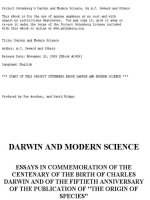Project Gutenberg’s Four Lectures on Mathematics, by Jacques Hadamard ppt
Bạn đang xem bản rút gọn của tài liệu. Xem và tải ngay bản đầy đủ của tài liệu tại đây (458.51 KB, 76 trang )
Project Gutenberg’s Four Lectures on Mathematics, by Jacques Hadamard
This eBook is for the use of anyone anywhere at no cost and with
almost no restrictions whatsoever. You may copy it, give it away or
re-use it under the terms of the Project Gutenberg License included
with this eBook or online at www.gutenberg.org
Title: Four Lectures on Mathematics
Delivered at Columbia University in 1911
Author: Jacques Hadamard
Release Date: August 24, 2009 [EBook #29788]
Language: English
Character set encoding: ISO-8859-1
*** START OF THIS PROJECT GUTENBERG EBOOK FOUR LECTURES ON MATHEMATICS ***
Produced by Andrew D. Hwang, Brenda Lewis and the Online
Distributed Proofreading Team at (This
file was produced from images from the Cornell University
Library: Historical Mathematics Monographs collection.)
transcriber’s notes
In Lecture IV, equation (2) on p. 47, and equation (3)
with its surrounding text on p. 52, are reproduced
faithfully from the original.
Except as noted above, minor typographical corrections
and regularizations of spelling and mathematical
notation have been made without comment. This ebook
may be easily recompiled with errors and irregularities
A
retained. Please consult the preamble of the L TEX
source file for instructions.
Figures may have been moved slightly with respect to
the surrounding text.
This PDF file is formatted for printing, but may be
easily formatted for screen viewing. Again, please see
the preamble of the source file for instructions.
COLUMBIA UNIVERSITY IN THE CITY OF NEW YORK
PUBLICATION NUMBER FIVE
OF THE ERNEST KEMPTON ADAMS FUND FOR PHYSICAL
RESEARCH
ESTABLISHED DECEMBER 17TH, 1904
FOUR LECTURES
ON MATHEMATICS
DELIVERED AT COLUMBIA UNIVERSITY
IN 1911
BY
J. HADAMARD
´
´
MEMBER OF THE INSTITUTE, PROFESSOR IN THE COLLEGE DE FRANCE AND IN THE ECOLE POLYTECHNIQUE,
LECTURER IN MATHEMATICS AND MATHEMATICAL PHYSICS IN COLUMBIA UNIVERSITY FOR 1911
NEW YORK
COLUMBIA UNIVERSITY PRESS
1915
Copyright 1915 by Columbia University Press
PRESS OF
THE NEW ERA PRINTING COMPANY
LANCASTER, PA.
1915
On the seventeenth day of December, nineteen hundred and four,
Edward Dean Adams, of New York, established in Columbia University
“The Ernest Kempton Adams Fund for Physical Research” as a memorial
to his son, Ernest Kempton Adams, who received the degrees of Electrical
Engineering in 1897 and Master of Arts in 1898, and who devoted his life
to scientific research. The income of this fund is, by the terms of the deed
of gift, to be devoted to the maintenance of a research fellowship and to
the publication and distribution of the results of scientific research on the
part of the fellow. A generous interpretation of the terms of the deed on
the part of Mr. Adams and of the Trustees of the University has made it
possible to issue these lectures as a publication of the Ernest Kempton
Adams Fund.
Publications of the
Ernest Kempton Adams Fund for Physical Research
Number One. Fields of Force. By Vilhelm Friman Koren
Bjerknes, Professor of Physics in the University of Stockholm.
A course of lectures delivered at Columbia University, 1905-6.
Hydrodynamic fields. Electromagnetic fields. Analogies between
the two. Supplementary lecture on application of hydrodynamics
to meteorology. 160 pp.
Number Two. The Theory of Electrons and its Application to
the Phenomena of Light and Radiant Heat. By H. A.
Lorentz, Professor of Physics in the University of Leyden. A
course of lectures delivered at Columbia University, 1906–7. With
added notes. 332 pp. Edition exhausted. Published in another
edition by Teubner.
Number Three. Eight Lectures on Theoretical Physics. By Max
Planck, Professor of Theoretical Physics in the University of
Berlin. A course of lectures delivered at Columbia University
in 1909, translated by A. P. Wills, Professor of Mathematical
Physics in Columbia University.
Introduction: Reversibility and Irreversibility. Thermodynamic
equilibrium in dilute solutions.
Atomistic theory of matter.
Equation of state of a monatomic gas. Radiation, electrodynamic
theory. Statistical theory. Principle of least work. Principle of
relativity. 130 pp.
Number Four. Graphical Methods. By C. Runge, Professor of Applied Mathematics in the University of Găttingen. A course of
o
lectures delivered at Columbia University, 190910.
Graphical calculation. The graphical representation of functions
of one or more independent variables. The graphical methods of
the differential and integral calculus. 148 pp.
Number Five. Four Lectures on Mathematics. By J. Hadamard,
Member of the Institute, Professor in the Coll`ge de France and
e
´
in the Ecole Polytechnique. A course of lectures delivered at
Columbia University in 1911.
Linear partial differential equations and boundary conditions. Contemporary researches in differential and integral equations. Analysis situs. Elementary solutions of partial differential equations
and Green’s functions. 53 pp.
Number Six. Researches in Physical Optics, Part I, with especial
reference to the radiation of electrons. By R. W. Wood,
Adams Research Fellow, 1913, Professor of Experimental Physics
in the Johns Hopkins University. 134 pp. With 10 plates. Edition
exhausted.
Number Seven. Neuere Probleme der theoretischen Physik. By
W. Wien, Professor of Physics in the University of Wărzburg.
u
A course of six lectures delivered at Columbia University in
1913.
Introduction: Derivation of the radiation equation. Specific heat
theory of Debye. Newer radiation theory of Planck. Theory of
electric conduction in metals, electron theory for metals. The
Einstein uctuations. Theory of Răntgen rays. Method of detero
mining wave length. Photo-electric effect and emission of light
by canal ray particles. 76 pp.
These publications are distributed under the Adams Fund to many
libraries and to a limited number of individuals, but may also be bought
at cost from the Columbia University Press.
PREFACE
The “Saturday Morning Lectures” delivered by Professor Hadamard at Columbia University in the fall of 1911, on subjects
that extend into both mathematics and physics, were taken
down by Dr. A. N. Goldsmith of the College of the City of
New York, and after revision by the author in 1914 are now
published for the benefit of a wider audience. The author
has requested that his thanks be expressed in this place to
Dr. Goldsmith for writing out and revising the lectures, and
to Professor Kasner of Columbia for reading the proofs.
CONTENTS
Lecture I.
The Definition of Solutions of Linear Partial Differential Equations by Boundary Conditions.
Lecture II. Contemporary Researches in Differential Equations, Integral Equations, and Integro-Differential Equations.
Lecture III. Analysis Situs in Connection with Correspondences and Differential Equations.
Lecture IV. Elementary Solutions of Partial Differential Equations and Green’s Functions.
LECTURE I
The Determination of Solutions of Linear Partial
Differential Equations by Boundary Conditions
In this lecture we shall limit ourselves to the consideration of
linear partial differential equations of the second order.
It is natural that general solutions of these equations were
first sought, but such solutions have proven to be capable of
successful employment only in the case of ordinary differential
equations. In the case of partial differential equations employed in connection with physical problems, their use must
be given up in most circumstances, for two reasons: first, it
is in general impossible to get the general solution or general
integral; and second, it is in general of no use even when it
is obtained.
Our problem is to get a function which satisfies not only
the differential equation but also other conditions as well;
and for this the knowledge of the general integral may be and
is very often quite insufficient. For instance, in spite of the
fact that we have the general solution of Laplace’s equation,
this does not enable us to solve, without further and rather
complicated calculations, ordinary problems depending on
that equation such as that of electric distribution.
Each partial differential equation gives rise, therefore, not
to one general problem, consisting in the investigation of all
solutions altogether, but to a number of definite problems,
each of them consisting in the research of one peculiar solution, defined, not by the differential equation alone, but by
the system of that equation and some accessory data.
The question before us now is how these data may be
chosen in order that the problem shall be “correctly set.”
But what do we mean by “correctly set”? Here we have to
proceed by analogy.
In ordinary algebra, this term would be applied to problems in which the number of the conditions is equal to that
of the unknowns. To those our present problems must be
2
FIRST LECTURE
analogous. In general, correctly set problems in ordinary algebra are characterized by the fact of having solutions, and
in a finite number. (We can even characterize them as having a unique solution if the problem is linear, which case
corresponds to that of our present study.) Nevertheless, a
difficulty arises on account of exceptional cases.
Let us consider a system of linear algebraic equations:
(1)
a1 x1 + · · · · · · + an xn = b1
.........................
.........................
the number n of these equations being precisely equal to
the number of unknowns. If the determinant formed by the
coefficients of these equations is not zero, the problem has
only one solution. If the determinant is zero, the problem
is in general impossible. At a first glance, this makes our
aforesaid criterion ineffective, for there seems to be no difference between that case and that in which the number of
equations is greater than that of the unknowns, where impossibility also generally exists. (Geometrically speaking, two
straight lines in a plane do not meet if they are parallel,
and in that they resemble two straight lines given arbitrarily in three-dimensional space.) The difference between the
two cases appears if we choose the b’s (second members of
the equation (1)) properly; that is, in such manner that the
system becomes again possible. If the number of equations
were greater than n, the solution would (in general) again
be unique; but, if those two numbers are equal, the problem
when ceasing to be impossible, proves to be indeterminate.
Things occur in the same way for every problem in algebra.
For instance, the three equations
f (x, y, z) = a
g(x, y, z) = b
f +g =c
LINEAR PARTIAL DIFFERENTIAL EQUATIONS
3
between the three unknowns x, y, z, constitute an impossible
system if c is not equal to a + b, but if c equals a + b, that
system is in general indeterminate.
Moreover, this fact has been both extended and made
precise by a most beautiful theorem due to Schoenflies.
Let
(2)
f (x, y, z) = X,
g(x, y, z) = Y,
h(x, y, z) = Z
be the equations of a space-transformation, the functions f ,
g, h being continuous. Let us suppose that within a given
sphere (x2 +y 2 +z 2 = 1, for instance), two points (x, y, z) cannot give the same single point (X, Y, Z): in other words, that
f (x, y, z) = f (x , y , z ), g(x, y, z) = g(x , y , z ), h(x, y, z) =
h(x , y , z ) cannot be verified simultaneously within that
sphere unless x = x , y = y , z = z . Let S denote the
surface corresponding to the surface s of the sphere; that is,
the surface described by the point (X, Y, Z) when (x, y, z)
describes s. If in equation (2) we consider now X, Y , Z
as given and x, y, z as unknown, our hypothesis obviously
means that those equations cannot admit of more than one
solution within s. Now Schoenflies’ theorem says that those
equations will admit of a solution for any (X, Y, Z) that may
be chosen within S. Of course the theorem holds for spaces
of any number of dimensions. It is obvious that this theorem
illustrates most clearly the aforesaid relation between the fact
of the solution being unique and the fact that that solution
necessarily exists.1
As said above, the theorem is in the first place remarkable
for its great generality, as it implies concerning the functions
f , g, h no other hypothesis but that of continuity. But its
1
We must note nevertheless, that in it the unique solution is opposed
not only to solutions in infinite number (as above), but also to any
more than one. For instance, the fact that x2 = X may have no
solution in x, is, from the point of view of Schoenflies’ theorem, in
relation with the fact that for other values of X, it may have two
solutions.
4
FIRST LECTURE
significance is in reality much more extensive and covers also
the functional field. I consider that its generalizations to that
field cannot fail to appear in great number as a consequence
of future discoveries. This remarkable importance will be my
excuse for digressing, although the theorem in question is only
indirectly related to our main subject. The general fact which
it emphasizes and which we stated in the beginning, finds
several applications in the questions reviewed in this lecture.
It may be taken as a criterion whether a given linear problem
is to be considered as analogous to the algebraic problems
in which the number of equations is equal to the number of
unknown. This will be the case always when the problem
is possible and determinate and sometimes even when it is
impossible, if it cannot cease (by further particularization
of the data) to be impossible otherwise than by becoming
indeterminate.
Let us return to partial differential equations. Cauchy was
the first to determine one solution of a differential equation
from initial conditions. For an ordinary equation such as
f (x, y, dy/dx, d2 y/dx2 ) = 0, we are given the values of y and
dy/dx for a particular value of x. Cauchy extended that
result to partial differential equations.
Let F (u, x, y, z, ∂u/∂x, ∂u/∂y, ∂u/∂z, ∂ 2 u/∂x2 , · · · ) = 0 be
a given equation of the second order and let it be granted
that we can solve it with respect to ∂ 2 u/∂x2 . Thus we obtain
(∂ 2 u/∂x2 ) + F1 = 0 where F1 is a function of all the above
quantities, except ∂ 2 u/∂x2 . Then Cauchy’s problem arises by
giving the values
(3)
u = ϕ(y, z),
∂u
= ψ(y, z)
∂x
of u and ∂u/∂x for x = 0. (These data must be replaced
by analogous data if, instead of the plane x = 0, we introduce another surface.) Indeed, under the above hypothesis
concerning the possibility of solving the equation with respect to ∂ 2 u/∂x2 , and on the supposition that the functions
F1 , φ and ψ are holomorphic, Cauchy, and after him, Sophie
LINEAR PARTIAL DIFFERENTIAL EQUATIONS
5
Kowalevska, showed that in this case there is indeed one and
only one solution. This solution can be expanded by Taylor’s
series in the form u = u0 + xu1 + x2 u2 + · · · where u0 , u1 , · · ·
can be calculated.
The above theorems are true for most equations arising in
connection with physical problems, for example
2
(E)
u=
∂ 2u
.
∂t2
But in general these theorems may be false. This we shall
realize if we consider Dirichlet’s problem: to determine the
solution of Laplace’s equation
(e)
2
u=
∂ 2u ∂ 2u ∂ 2u
+
+
=0
∂x2 ∂y 2 ∂z 2
for points within a given volume when given its values at
every point of the boundary surface S of that volume.
It is a known fact that this problem is a correctly set one:
it has one, and only one, solution. Therefore, this cannot be
the case with Cauchy’s problem, in which both u and one of its
derivatives are given at every point of S. If the first of these
data is by itself (in conjunction with the differential equation)
sufficient to determine the unknown function, we have no right
to introduce any other supplementary condition. How is it
therefore that, by the demonstration of Sophie Kowalevska,
the same problem with both data proves to be possible?
Two discrepancies appear between the sense of the question in one case and in the other: (a) In the theorem of Sophie
Kowalevska, u has only to exist in the immediate neighborhood of the initial surface S. In Dirichlet’s problem, it has to
exist and to be well determined in the whole volume limited
by S. We therefore require more in the latter case than in
the former, and it might be thought that this is sufficient to
resolve the apparent contradiction met with above.
In fact, however, this is not the case and we must also
take account of the second discrepancy. (b) The data, in
6
FIRST LECTURE
the case of the Cauchy-Kowalevska demonstration, are, as we
said, supposed to be analytic: the functions ϕ, ψ (second
members of (3)) considered as functions of y, z, are taken as
given by convergent Taylor’s expansions in the neighborhood
of every point of the plane x = 0 in the region where the
question is to be solved. Nothing of the kind is supposed in
the study of Dirichlet’s problem. Not even the existence of the
first derivatives of u, corresponding to displacements on S,
is postulated, and in some researches, certain discontinuities
of these values are admitted. Both these circumstances play
their rˆle in the explanation of the difference between the two
o
results discussed above.
That (a) is one reason for that difference is evident, for
of course, if a function is required to be harmonic (i. e. to admit everywhere derivatives and to verify Laplace’s equation)
within a sphere, its values and those of its normal derivative,
may not together be chosen arbitrarily on the surface even if
analytic.
To show that (a) is not sufficient for the required explanation, let us take the geometric terms of the problem in the
same way as Cauchy. We therefore suppose that, u being
defined by Laplace’s equation, the accessory data given to
determine it are the values of u and ∂u/∂x on the plane
x = 0, or, more exactly, on a certain portion Ω of that plane;
u will also not be required, now, to exist in the whole space;
its domain of existence may be limited, for instance, to a
certain distance, however small, from our plane x = 0 (in
the environs of Ω) provided that distance be finite and not
infinitesimal.
Now under these conditions, in general such a function u
does not exist, if the data are not analytic and are chosen
arbitrarily. One sees then a fact which never appeared as
long as ordinary differential equations were alone concerned,
namely, that the results are utterly different according as the
analytic character of the data is postulated or not.
Of these two opposite results which is to be considered as
LINEAR PARTIAL DIFFERENTIAL EQUATIONS
7
giving us a more correct and adequate idea of the nature of
things? I do not say as the true one, for of course each one
is so under proper specifications.
Some mathematicians still incline to prefer the old point of
view of Cauchy, one of their reasons being that, as known since
Weierstrass, any function, analytic or not, can be replaced
with any given approximation by an analytic one, (more
precisely by a polynomial). Therefore the fact that a function
belongs to one or the other of those two categories seems to
them to be immaterial. I cannot agree with this point of
view. That the thing is not immaterial, seems to me to
follow directly from what we have just stated. And it cannot
fail to be put in evidence if we think not only of the mere
existence of the solution, but of its properties and the means
of calculating it. If Cauchy’s problem, for equation (e), ceases
to be possible, as a rule, when the functions designated by ϕ,
ψ are not analytic, then every expression for the solution must
depend essentially on that analyticity and especially upon the
radii of convergence of the developments of ϕ, ψ. In other
words, let us imagine that the functions ϕ, ψ be replaced by
other functions ϕ1 , ψ1 , the differences ϕ1 − ϕ, ψ1 − ψ being
very small for every system of real values of y, x within Ω (and
perhaps also the differences of some derivatives being small).
However slight the alteration may be it rigorously follows
from the aforesaid theorem of Weierstrass, that the radii of
convergence of the developments in power series (if existing
at all) may and will be, in general, completely changed; so
the calculations leading to the solution will necessarily be
changed also.
If that solution itself should undergo but a slight change,
this would at once show us that these methods of calculation
ought to be of quite an artificial nature, masking completely
the qualitative properties of the required result.2 But in
2
The solution by development in Taylor’s series is, in general, for
problems of that kind, the only one which can be given. I know but
one exception, which is Schwarz’s method for minimal surfaces, when
8
FIRST LECTURE
fact, it is clear that matters are not as just assumed above.
The alteration u1 − u produced on the values of u by our
slight modification of ϕ, ψ will be generally important and
often complete, as is evident3 by the fact that u will cease
completely to exist when ϕ, ψ become non-analytical. This
proves, first of all, that the application of Weierstrass’ theorem
in that case is illegitimate, since it gives an approximation
for the data but nothing of the kind for the unknown.
Then we see also that such a problem and calculation, the
results of which are utterly changed by an infinitesimal error
in starting, can have no meaning in their applications.
This leads to my second and chief reason for considering only the results which correspond to non-analytic data,
namely, the remarkable accordance between them and the
results to which physical applications bring us.
This accordance is the more interesting from the fact of its
results being unexpected. Our former point of view—i. e. that
of the Cauchy-Kowalevska theorem—evidently constitutes a
complete analogy to the case of ordinary differential equations. But from our latter point of view—which is also the
point of view in problems set by physical applications—every
analogy seems to be upset. The results often seem almost
incoherent; they will give opposite conclusions in apparently
similar questions.
A first instance of this was given above. We know that
a curve of the surface and the corresponding succession of tangent
planes are given. This method rests on the favorable and exceptional
circumstance that complex variables can be employed for the study of
real points of such a surface.
3
If u1 −u should be uniformly very small at the same time as ϕ1 −ϕ,
ψ1 − ψ, it follows from the well-known convergence theorem of Cauchy
that, letting the analytic functions ϕ1 , ψ1 , converge towards certain
(non-analytic) limiting functions ϕ, ψ, the corresponding solution u1
ought to converge uniformly towards a certain limit u, which would be
a solution of the problem with the data ϕ, ψ.
LINEAR PARTIAL DIFFERENTIAL EQUATIONS
9
Cauchy’s problem is now impossible for Laplace’s equation
(e)
2
u=
∂ 2u ∂ 2u ∂ 2u
+
+
= 0;
∂x2 ∂y 2 ∂z 2
but, on the contrary, in the equation of spherical waves
(E)
∂ 2u ∂ 2u ∂ 2u ∂ 2u
+
+
− 2 = 0,
∂x2 ∂y 2 ∂z 2
∂t
or of the cylindrical waves
(E )
∂ 2u ∂ 2u ∂ 2u
+
− 2 = 0,
∂x2 ∂y 2
∂t
we may assign arbitrarily the values (whether analytical or
not) of u and δu/δt for t = 0, and Cauchy’s problem set
in that way has a solution (which is unique). In this latter
case it is like a problem in algebra in which the number of
equations is equal to the number of unknowns; in the former,
like a problem in which the number of equations is superior4
to the number of unknowns.
It never could have been imagined a priori that such a
difference could depend on the mere changing of sign of a
coefficient in the equation. But it is entirely conformable to
the physical meaning of the equations. Equation (E ), for
instance, governs the small motions of a homogeneous and
isotropic medium, like a homogeneous gas; and the corresponding Cauchy’s problem, enunciated above, represents the
definition of the motion by giving the state of positions and
4
We could be tempted to apply in that case the remark made
in the beginning (p. 4) concerning such impossible problems, which,
notwithstanding that circumstance, must be considered as resembling
“correctly set” ones. This, however, is not really applicable; for we
have seen that the category alluded to is recognized by the fact that the
problem may, under more special circumstances, become indeterminate.
Now, this can never be the case in the present question: it follows from
a theorem of Holmgren (“Archiv făr Mathematik) that the solution
u
of Cauchys problem, if existent, is in every possible case unique.
10
FIRST LECTURE
speeds at the origin of times. On the contrary, equation (e),
which also governs many physical phenomena, never leads
to problems of that kind but exclusively to problems of the
Dirichlet type. The analytical criterion by which those two
kinds of partial differential equations are to be distinguished,
is known: it is given by what are called the characteristics
of an equation. The characteristics of an equation correspond
analytically with what the physicist calls the waves compatible with this equation, and are calculated in the following way.
Let a wave be represented by the equation P (x, y, z, t) = 0.
In the given equation, for instance, if 2 u−1/a2 ·∂ 2 u/∂t2 = 0
and 2 u be replaced by (∂P/∂x)2 +(∂P/∂y)2 +(∂P/∂z)2 and
−(1/a2 )(∂ 2 u/∂t2 ) by −(1/a2 )(∂P/∂t)2 the condition thus obtained is
∂P
∂x
2
+
∂P
∂y
2
+
∂P
∂z
2
∂P
∂t
1
− 2
a
2
=0
(which is a partial differential equation of the first order).
It must be verified by the function P . When this holds,
P (x, y, z, t) = 0 is said to be a characteristic of the given
equation.
For equation (E), such characteristics exist (that is, are
real); this case is called the hyperbolic one.
Laplace’s equation, 2 u = 0, on making the above substitution, leads to the equation
∂P
∂x
2
+
∂P
∂y
2
+
∂P
∂z
2
=0
which has no real solution. Therefore, in this case there are
no waves and we have the so-called elliptic case.5 Cauchy’s
problem can be set for a hyperbolic equation, but not for an
elliptic one. Does this mean that for a hyperbolic equation
5
An intermediate case exists 2 u − k(∂u/∂t) = 0. This is semidefinite and is termed the parabolic one (example: the equation of
heat).
LINEAR PARTIAL DIFFERENTIAL EQUATIONS
11
Cauchy’s problem will always arise? No, the matter is not
quite so simple. For instance, in equation (E) or (E ), we
could not choose arbitrarily u and ∂u/∂y for x = 0; this would
lead us again to an impossible problem (in the non-analytic
case, of course).
The physical explanation of this lies in the fact that there
are, besides the partial differential equation, two kinds of
conditions determining the course of a phenomenon, viz., the
initial and the boundary conditions. The former are of the
type of Cauchy and they alone intervene in Cauchy’s problem
quoted above for the equation of sound.
But the boundary conditions are always of the type of
Dirichlet. They are the only ones which can occur in an
elliptic equation, but even in a hyperbolic one they generally
present themselves together with initial ones. This gives
place to so-called mixed problems where the two kinds of data
(belonging respectively to the Cauchy and to the Dirichlet
type) intervene simultaneously for the determination of the
unknown.
In equation (E), t = 0 represents the origin of time and can
give place to initial conditions, having the form of Cauchy.
But no such conditions can correspond to x = 0, which
represents a geometric boundary.
More or less complicated cases can arise for various dispositions of the configurations, giving place to other paradoxical
and apparently contradictory results, which can however all
be explained in the same way. Moreover, there are other
types of linear partial differential equations,6 which do not
govern any physical phenomena. The determination of solutions has been studied7 in the analytic case but no sort of
6
The so-called non-normal hyperbolic equations, such as
∂2u
∂2u
∂2u
∂2u
2 + · · · ∂x2 − ∂y 2 · · · ∂y 2 = 0
x1
m
n
1
7
(m > 1, n > 1).
By Hamel (Inaugural Dissertation, Găttingen) and Coulon (thesis,
o
Paris).
12
FIRST LECTURE
determination of that kind for non-analytic data has been
discovered hitherto.
We see that from this non-analytic point of view the
accordance between mathematical results and the suggestions
of physics holds perfectly. This accordance must not surprise
us, for, as we saw above, it corresponds to the fact that a
problem which is possible only with analytic data can have
no physical meaning. But it remains worth all our attention.
No other example better illustrates Poincar´’s views8 on the
e
help which physics brings to analysis as expressed by him in
such statements as the following: “It is physics which gives us
many important problems, which we would not have thought
of without it,” and “It is by the aid of physics that we can
foresee the solutions.”
8
Lectures delivered at the first International Mathematical Congress,
Zurich, 1897; reproduced in “La Valeur de la Sciences.”
LECTURE II
Contemporary Researches in Differential
Equations, Integral Equations, and
Integro-Differential Equations
1. Partial Differential Equations and Integral Equations
I reminded you at the end of the last lecture what indispensable help the physicist renders to the mathematician in
furnishing him with problems. But that help is not always
free from inconveniences, and the task of the mathematician
is often a thankless one. Two cases generally occur: it may
happen that the physical problem is easily soluble by a mere
“rule of three” method, but if not, it is so extremely difficult
that the mathematician despairs of solving it at all; and he
will strive after that solution for two centuries and, when he
obtains it, our interest in the particular physical problem may
have been lost. Such seems to be the case with some problems concerning partial differential equations. Just after the
discovery of infinitesimal calculus, physicists began by needing only very simple methods of integration, the problems
in general reducing to elementary differential equations. But
when higher partial differential equations were introduced,
the corresponding problems almost immediately proved to be
far above the level of those which contemporary mathematics
could treat.
Indeed, those problems (such as Dirichlet’s) exercised the
sagacity of geometricians and were the object of a great deal
of important and well-known work through the whole of the
nineteenth century. The very variety of ingenious methods
applied showed that the question did not cease to preserve
its rather mysterious character. Only in the last years of
the century were we able to treat it with some clearness and
understand its true nature. This clearness seemed to come
too late, for at that time, physics began its present evolution
in which it seems to disregard partial differential equations
14
SECOND LECTURE
and to come back to ordinary differential equations, but of
course in problems profoundly different from the simple cases
which were familiar to Bernoulli or Euler.
Happily, for it would have been a humiliating thing to
work so uselessly, this disregard was only in appearance,
and the ancient problems have not lost their importance by
the fact that other ones have been superposed on and not
substituted for them. In fact, the solution now obtained
for Dirichlet’s problem has proved useful in several recent
researches of physics.
Let us therefore inquire by what device this new view of
Dirichlet’s problem and similar problems was obtained. Its
peculiar and most remarkable feature consists in the fact that
the partial differential equation is put aside and replaced by
a new sort of equation, namely, the integral equation. This
new method makes the matter as clear as it was formerly
obscure.
In many circumstances in modern analysis, contrary to
the usual point of view, the operation of integration proves
a much simpler one than the operation of derivation. An
example of this is given by integral equations where the
unknown function is written under such signs of integration
and not of differentiation. The type of equation which is thus
obtained is much easier to treat than the partial differential
equation.
The type of integral equations corresponding to the plane
Dirichlet problem is
B
(1)
φ(x) − λ
φ(y)K(x, y) dy = f (x)
A
where φ is the unknown function of x in the interval (A, B),
f and K are known functions, and λ is a known parameter.
The equations of the elliptic type in many-dimensional space
give similar integral equations, containing however multiple
integrals and several independent variables. Before the introduction of equations of the above type, each step in the
CONTEMPORARY RESEARCHES IN EQUATIONS
15
study of elliptic partial differential equations seemed to bring
with it new difficulties; not only did the various methods
imagined for Dirichlet’s problem not cast more than a partial
light on the question, but the principles of most of them were
peculiar to that special problem: they seemed to disappear if
Laplace’s equation was replaced by any other equation of the
same type, or even (except for Neumann’s method, which,
as we shall soon see, is directly related to integral equations)
if for the same Laplace’s equation Dirichlet’s problem was
replaced by any analogous one such as presented by hydrodynamics or theory of heat. Each of them, besides, was rather
a proof of existence than a method of calculation.
Then they seemed again quite insufficient for another
series of questions which mathematical physics had to solve,
viz., the study of harmonics. The existence of those harmonics
(such as the different kinds of resonance of a room filled with
air) was physically evident, but for the mathematician it offers
an immense difficulty. Schwarz, Picard and Poincar´ gave a
e
first solution which was rather complicated as each harmonic
requires for its definition a new infinite process of calculation
after the preceding one has been determined. Nevertheless
it has demonstrated rigorously the chief properties of the
quantities in question (namely, certain special values of the
parameter in equation (1)), i. e. that they exist and form a
discrete infinity, only a finite number of them lying within
any finite interval.
But at the same time a discovery even more important,
in a certain sense, was made by Poincar´, namely the near
e
relation between that question of harmonics and the method
which had been indicated by Neumann for Dirichlet’s problem.
This discovery of Poincar´ paved the way for Fredholm’s work.
e
The latter treats every one of the aforesaid questions, and
any which can be assimilated to them, by one and the same
method, which consists in the reduction to an equation such
as (1). This gives all the required results at once and for all
the possible types of such problems.









